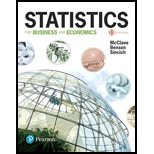
Can money spent on gifts buy love? Is the gift you purchased for that special someone really appreciated? This was the question of interest to business professors at Stanford University. Their research was published in the Journal of Experimental Social Psychology (Vol. 45, 2009). In one study, the researchers investigated the link between engagement ring price (dollars) and level of appreciation of the recipient (measured on a 7-point scale where 1 = “not at all” and 7 = “to a great extent”). Participants for the study were those who used a popular Web site for engaged couples. The Web site's directory was searched for those with “average” American names (e.g., “John Smith,” “Sara Jones”). These individuals were then invited to participate in an online survey in exchange for a $10 gift certificate. Of the respondents, those who paid really high or really low prices for the ring were excluded, leaving a
- a. Identify the experimental units for this study.
- b. What are the variables of interest? Are they quantitative or qualitative in nature?
- c. Describe the population of interest.
- d. Do you believe the sample of 33 respondents is representative of the population? Explain.
- e. In a second designed study, the researchers investigated whether the link between gift price and level of appreciation is stronger for birthday gift-givers than for birthday gift-receivers. The participants were randomly assigned to play the role of gift-giver or gift-receiver. Assume that the sample consists of 50 individuals. Use a random number generator to randomly assign 25 individuals to play the gift-receiver role and 25 to play the gift-giver role.
Want to see the full answer?
Check out a sample textbook solution
Chapter 1 Solutions
Statistics for Business and Economics (13th Edition)
Additional Math Textbook Solutions
Math in Our World
Elementary Statistics: Picturing the World (7th Edition)
Introductory Statistics
APPLIED STAT.IN BUS.+ECONOMICS
College Algebra (Collegiate Math)
- 7 (Multivariate random variable) Suppose X, €1, €2, €3 are IID N(0, 1) and Y2 Y₁ = 0.2 0.8X + €1, Y₂ = 0.3 +0.7X+ €2, Y3 = 0.2 + 0.9X + €3. = (In models like this, X is called the common factors of Y₁, Y₂, Y3.) Y = (Y1, Y2, Y3). (a) Find E(Y) and cov(Y). (b) What can you observe from cov(Y). Writearrow_forward1 (VaR and ES) Suppose X ~ f(x) with 1+x, if 0> x > −1 f(x) = 1−x if 1 x > 0 Find VaRo.05 (X) and ES0.05 (X).arrow_forwardJoy is making Christmas gifts. She has 6 1/12 feet of yarn and will need 4 1/4 to complete our project. How much yarn will she have left over compute this solution in two different ways arrow_forward
- Solve for X. Explain each step. 2^2x • 2^-4=8arrow_forwardOne hundred people were surveyed, and one question pertained to their educational background. The results of this question and their genders are given in the following table. Female (F) Male (F′) Total College degree (D) 30 20 50 No college degree (D′) 30 20 50 Total 60 40 100 If a person is selected at random from those surveyed, find the probability of each of the following events.1. The person is female or has a college degree. Answer: equation editor Equation Editor 2. The person is male or does not have a college degree. Answer: equation editor Equation Editor 3. The person is female or does not have a college degree.arrow_forwardneed help with part barrow_forward
- Suppose you know that Bob's test score is above the mean, but he doesn't remember by how much. At least how many students must score lower than Bob?arrow_forwardIf a baby's weight is at the median, what's her percentile?arrow_forwardAt the same restaurant as in Question 19 with the same normal distribution, what's the chance of it taking no more than 15 minutes to get service?arrow_forward
- Clint, obviously not in college, sleeps an average of 8 hours per night with a standard deviation of 15 minutes. What's the chance of him sleeping between 7.5 and 8.5 hours on any given night? 0-(7-0) 200 91109s and doiw $20 (8-0) mol 8520 slang $199 galbrog seam side pide & D (newid se od poyesvig as PELEO PER AFTE editiw noudab temand van Czarrow_forwardTimes to complete a statistics exam have a normal distribution with a mean of 40 minutes and standard deviation of 6 minutes. Deshawn's time comes in at the 90th percentile. What percentage of the students are still working on their exams when Deshawn leaves?arrow_forwardSuppose that the weights of cereal boxes have a normal distribution with a mean of 20 ounces and standard deviation of half an ounce. A box that has a standard score of o weighs how much? syed by ilog ni 21arrow_forward
 Big Ideas Math A Bridge To Success Algebra 1: Stu...AlgebraISBN:9781680331141Author:HOUGHTON MIFFLIN HARCOURTPublisher:Houghton Mifflin Harcourt
Big Ideas Math A Bridge To Success Algebra 1: Stu...AlgebraISBN:9781680331141Author:HOUGHTON MIFFLIN HARCOURTPublisher:Houghton Mifflin Harcourt Glencoe Algebra 1, Student Edition, 9780079039897...AlgebraISBN:9780079039897Author:CarterPublisher:McGraw Hill
Glencoe Algebra 1, Student Edition, 9780079039897...AlgebraISBN:9780079039897Author:CarterPublisher:McGraw Hill Holt Mcdougal Larson Pre-algebra: Student Edition...AlgebraISBN:9780547587776Author:HOLT MCDOUGALPublisher:HOLT MCDOUGAL
Holt Mcdougal Larson Pre-algebra: Student Edition...AlgebraISBN:9780547587776Author:HOLT MCDOUGALPublisher:HOLT MCDOUGAL


